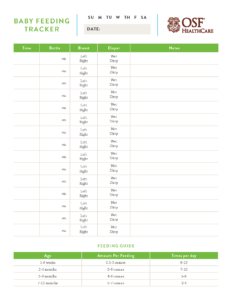Whether you’re breastfeeding or formula feeding your baby, they’ve got to eat.
Sarah Musselman, RN, a lactation specialist at OSF HealthCare, shared some expertise about the dos and don’ts and all the options you have for feeding your baby.
Feeding during the first month

Baby feeding tracker
Download
During that first month after birth, you’re likely trying to figure out a good feeding routine for baby.
All babies are different and can have their own unique needs. But here are Sarah’s top six tips for getting started.
- Baby doesn’t need anything but breast milk or formula for the first six months. Babies don’t need extra water because they’re getting everything they need through breast milk or formula.
- Baby won’t start solid foods until about six months or when your pediatrician recommends is best.
- A newborn will drink about 0.5-3 ounces of milk at each feeding. When a baby is first born, their tummy is very tiny – about the size of a marble – so they don’t need a lot to fill it up.
- You’ve probably heard the old wives tale don’t wake a sleeping baby. However, you should wake your baby to feed every two to three hours in the beginning. If it’s time to eat and they’re still sleeping, try skin to skin. If they haven’t woken up in 15 minutes, you could try getting them up and moving: change a diaper, change clothes, walk baby around or hold baby upright and facing out.
- Breastfed babies should be fed on cue – when they show signs of hunger, such as sucking on hands or looking for your nipple if they’re being held – because they’re still figuring out how to nurse.
- Babies will lose weight in the first few days after delivery, and that’s perfectly normal. After about four to five days, baby will start to gain the lost weight or exceed birth weight.
How much should a baby eat?
Breastfed babies
“One of the biggest concerns breastfeeding mamas have is if their baby is getting enough milk.” Sarah said.
Since you can’t see how much milk is coming out, you can’t tell how much milk baby is taking in.
“Breast milk changes along with babies. Because baby’s tummy starts tiny, mom will make a tiny amount of milk. As the baby’s tummy gets bigger, mom will produce more milk because there’s a higher demand,” Sarah said.
In the first few weeks, babies eat smaller portions more often throughout the day and night. It doesn’t mean you’re not making enough milk.
You can’t breastfeed your baby too often, but you can breastfeed too infrequently. It’s up to mom and baby to decide how long to breastfeed, but the American Association of Pediatrics recommends breastfeeding up until age 2.
Bottle-feeding newborn
Whether it’s pumped breast milk or baby formula , bottle feeding may be the route to go. You can do exclusively bottle feeding or a mixture of bottle and breastfeeding. The breastfeeding and formula feeding schedule is about the same. Baby eats smaller portions frequently throughout the day and night – about eight to 12 times each day.
Babies who are bottle fed may take in more air while eating, leading to gassiness and fussiness. Taking a break in the middle of a feeding to burp baby may help. And, if you’re feeding your baby a lot, try giving fewer ounces at the next feeding.
“Gone are the days when a baby needs to eat seven or eight ounces per feeding. Four to six ounces should do,” Sarah said.
When babies stop drinking formula around age 1, they’re usually ready to eat exclusively solid foods and drink cow’s or nut milk.
How to bottle feed
“Whoever is feeding baby should hold the bottle. Never prop the bottle against something,” Sarah said.
Questions about feeding your baby?
If the baby starts to cough or choke while drinking from a bottle, make sure you’re holding baby in a good position – baby’s ear, shoulder and hip should all be aligned.
The type of bottle or nipple may be causing a problem, too. Baby may be getting too much liquid out with each gulp, which can cause them to choke. Talk to your pediatrician about the best bottle and nipple options for your baby.
If your baby is choking often, definitely talk to your baby’s pediatrician. It may be a sign that your baby has reflux, a tongue tie or hasn’t figured out the right sucking motion.
Cluster feeding a newborn
Sometimes babies want to eat frequently in a short span of time. This is called cluster feeding. It may be exhausting for mom, but it likely only last a few days.
A baby will most likely cluster feed in the first few months, but some babies don’t cluster feed.
“When babies do cluster feed, it could be a sign they’re going through a growth spurt or they’re just looking for some extra comfort,” Sarah said.
Cluster feeding is often thought of as happening only to breastfed babies, but that isn’t always the case. Formula-fed babies often fall into the habit of cluster feeding, as well.
Signs of cluster feeding might include:
- Shorter intervals between each feeding
- Shorter naps
- Crabbiness
- Breaks suction on breast and returns a few minutes later
Last Updated: June 20, 2023
